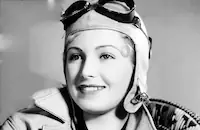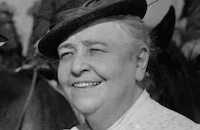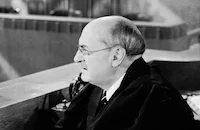Nancy Steele Is Missing!
Brief Synopsis
Cast & Crew
George Marshall
Victor Mclaglen
Walter Connolly
Peter Lorre
June Lang
Robert Kent
Film Details
Technical Specs

Synopsis
Shortly before the entry of the United States into World War I, Dennie O'Neill brings a baby to the New Jersey home of his friends, Joseph and Mary Flaherty, whom he has not seen for ten years. Dennie tells them that his wife died during the birth of the baby, whom he calls Sheila, and asks that they take care of her while he is away for a month or six weeks. During the conversation, Dennie rails against munitions tycoon Michael Steele and his kind, who, Dennie insists, would like the country to enter the war, which, Dennie argues, the United States should avoid. Dennie then goes to a nearby swamp, where he hides a strongbox in a tree trunk and sinks his car. A week later, Dennie, a servant at an exclusive New York club, overhears Michael Steele express anguish that the kidnapper of his baby daughter has not sent a note. That night, the police enter Dennie's room to arrest him for knocking out the teeth of an Italian American who called him pro-German. Thinking that he is wanted for the kidnapping, Dennie breaks a bottle over the head of an officer. He is sentenced to two years in prison, where he shares a cell with Professor Sturm, a mysterious little man who is serving time for manslaughter, which, he readily admits, was actually murder. Sturm learns bits of information about the kidnapping from Dennie's ravings during dreams, a letter he sends to Joe and a newspaper clipping. After another prisoner provokes a fight with Dennie in the mess hall in order to start a riot and thus create a situation that would favor an escape attempt, Dennie is sentenced to life imprisonment for complicity in the incident, which has resulted in the deaths of several persons. Years later, during the Depression, Dennie is let out early for good behavior. The professor, who had been released earlier, follows Dennie to Joe's home. Dennie arrives just as Joe, who has suffered a stroke, is dying. Sheila hugs Dennie, who, she believes, is her father, and cries in his arms. Dennie then retrieves the strongbox and takes Sheila to New York. He leaves a note in Steele's office that Steele's daughter Nancy is alive and gives instructions on how to contact him. Steele then recognizes Dennie in the building's bar and invites him to the office. After Steele offers him a job at his cottage as a gardener, Dennie accepts and retrieves the unopened note. Sheila lives with her father at the cottage and works in Manhattan. One night, Steele drives Sheila home from the station during a rain storm and overhears Dennie angrily berating Sheila's boyfriend Jimmie on the telephone for keeping Sheila out late. Embarrassed before Steele, who, Dennie realizes, is an open-hearted man, and contrite before Sheila, whom he has grown to love, Dennie apologizes to Sheila and burns the ransom letter. After Sturm contacts Steele's lawyer to say that he has Nancy Steele, Dennie, greatly agitated, goes to the greenhouse and gets out the strongbox, which contains the kidnapped child's baby sock. Sturm then enters with a pistol and demands the strongbox. When Dennie refuses, the professor shoots him and takes the box. Steele gets Dennie the best surgeon, and when Dennie revives and learns that a former movie ticket seller has been identified as Nancy Steele, Dennie gets a gun and tracks down Sturm. He brings Sturm to Steele's home and shoots him in the hand to make him admit that the ticket seller is not Nancy. Dennie then confesses that he kidnapped Nancy and reveals that she is Sheila, before he collapses from his injury. At the prison hospital, Dennie refuses to see Sheila, who has tried to visit him, but he is glad to learn that she and Jimmie are going to be married. Dennie explains to the warden that now that she has a real father and a husband, it is better for her to forget him. Through the high window, Dennie watches Sheila and Jimmie leave the prison.

Director

George Marshall
Cast

Victor Mclaglen

Walter Connolly

Peter Lorre

June Lang
Robert Kent
Shirley Deane

John Carradine

Jane Darwell

Frank Conroy

Granville Bates
George Taylor
Kane Richmond
Margaret Fielding

De Witt Jennings
George Chandler
George Humbert
Robert Murphy
Ed Dearing
Helen Jerome Eddy
Paul Mcvey
Eric Wilton
Alex Pollard
William Jeffrey
Sam Ash
Otto Hoffman
Denis D'auburn
Paul Sutton
Richard Terry
Robert E. Homans
Harry Semels
Frank Shannon
Lee Shumway
Henry Otho
Edward Gargan
Gus Robinson
Huey White
Horace Murphy
Bud Marshal
Philip Morris
Oscar Apfel
Buck Mack
Lew Harvey
Russ Clark
Harry Tyler
Frank Coleman
Stanley Andrews
Guy Usher
Frederick Burton
Mary Gordon
John Ince
Ed Brady
Hal Neiman
Crew
Bill Abbott
Frank Beetson
David Buttolph
Henry Carey
Jack Les Coulie
Harry Dawe
Doris Drought
Ed. Ebele
Herbert Farjeon
Gene Fowler
Bill Fremdling
Earl Haley
Roger Heman
Nunnally Johnson
Gertrude Kirkwood
Audrey Lindley
Thomas Little
H. W. Lombard
Hal Long
Raymond Lopez
Harvey Manger
Joe Mazzoletti
Jack Mcedwards
Barney Mcgill
Arthur Mclaglen
Bob Mclaughlin
Steve Mcnulty
Paul Monroe
Phillip Moore
Jack Murray
Skeets Noyes
Ed O'fearna
George Peckham
Hans Peters
Eddie Petzoldt
Charles Raudebraugh
C. E. Richardson
Wilma Ryan
Walter [m.] Scott
Bert Sebell
Samuel Francis Smith
George Switzer
Tommy Vincent
Gwen Wakeling
E. Clayton Ward
Darryl F. Zanuck

Film Details
Technical Specs

Quotes
Trivia
Notes
The working title of this film was The Lost Nancy Steele. The novel first appeared in serial form in The Saturday Evening Post (5 May-9 June 1934). According to New York Times, Otto Preminger was assigned to direct this film and Wallace Beery to be in it after production on The Last Slaver, which was released as Slave Ship (see below), was postponed. Tay Garnett, who was assigned to direct the latter film, was switched to Love Is News to replace Preminger on that film because one of the stars, Loretta Young, thought Preminger was "too foreign to direct such a strong American story." New York Times reported that Beery raised "strenuous objections" to appearing in this film. In his autobiography, Preminger relates that he was told by Darryl Zanuck's emissary, Gregory Ratoff, that Beery refused to "make a film with a director whose name he can't pronounce." According to a Hollywood Reporter news item, production was halted on November 28, 1936 after four days of work, and the footage shot was scrapped, as George Marshall took over direction from Preminger. In addition, Peter Lorre was rushed from New York to play the role of "Professor Sturm," which previously had been played by Walter Connolly. Connolly then took over the role of "Michael Steele." According to Los Angeles Times, this film was considered as a starring picture for Jean Hersholt, after his success in Reunion (see below), but after it was altered considerably from the original version, it was not thought to be suitable for Hersholt. According to a first draft continuity in the Twentieth Century-Fox Produced Scripts Collection at the UCLA Theater Arts Library, Hersholt was tentatively considered for the role that McLaglen played, as was Lionel Barrymore; Osgood Perkins, Otto Kruger, Jack Holt and John Halliday were considered for the role that Connolly played; Jane Wyatt, Frances Farmer, Frances Dee and Jean Parker were considered for the role that Lang played; and John Barrymore and Adolphe Menjou were considered for the role played by Peter Lorre. Edward Cronjager is credited with photography in the trade advertising billing sheet, and Sidney Wagner is listed as first cameramen at the start of production in the Twentieth Century-Fox Records of the Legal Department, also at UCLA, while all other sources, including the onscreen credits, list only Barney McGill. It has not been determined whether Cronjager or Wagner were actually involved with the production. John Harrington and Arthur Hohl are listed as cast members in Hollywood Reporter production charts, but their participation in the final film has not been confirmed. According to the legal records, the prison yard scenes were shot at M-G-M, and Warden Lewis E. Lawes of Sing Sing Prison was paid $1,500 by Twentieth Century-Fox for a radio broadcast he gave from the prison on NBC's "Hollywood Hotel" program in which he praised the film.
The MPAA/PCA Collection at the AMPAS Library contains correspondence from PCA Director Joseph Breen to the studio in which he states that the final script, dated November 16, 1936, "appears to us to be in violation of the regulations, 'Re Crime in Motion Pictures,' approved by the Board of Directors of the MPPDA, as of February 15, 1935" concerning kidnapping. He noted that the regulations instruct the PCA to mark such stories as acceptable under the Production Code "only when the kidnapping or abduction is (a) not the main theme of the story; (b) the person kidnapped is not a child; (c) there are no 'details of the crime' of kidnapping; (d) no profit accrues to the abductors or kidnappers; and (e) where the kidnappers are punished." Because, Breen wrote, the script violated subdivisions (a) and (b), it could not be approved. Although there were subsequent changes to the script, several reviewers commented that the final film, which the PCA did pass, still violated its regulations. New York Times noted that the film "represents as glib a double-cross of the Hays code as the screen has executed this year....[the producers] cheerfully scuttled 1) the rule forbidding the screen to deal with kidnapping and 2) the even more dogmatic regulation against the sympathetic portrayals of criminals." Time commented, "To discover a new ingredient for the formula of cinema kidnapping is a feat that might well deserve an Academy Award. To succeed in presenting as a hero a kidnapper who will not only arouse the sympathies of the audience but do so without raising the hackles of the Hays organization is another. Nancy Steele Is Missing does both."












